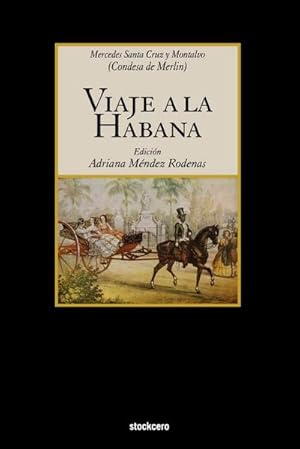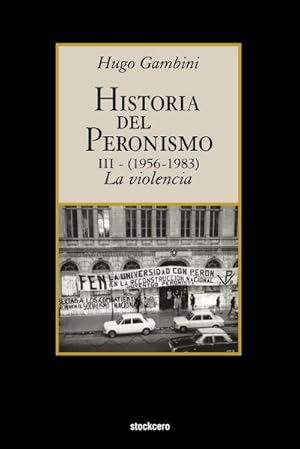stockcero dez 2008 (3 results)
Product Type
- All Product Types
- Books (3)
- Magazines & Periodicals
- Comics
- Sheet Music
- Art, Prints & Posters
- Photographs
- Maps
-
Manuscripts &
Paper Collectibles
Condition
- All Conditions
- New
- Used
Binding
- All Bindings
- Hardcover
- Softcover
Collectible Attributes
- First Edition
- Signed
- Dust Jacket
- Seller-Supplied Images
- Not Printed On Demand
Seller Location
Seller Rating
-
Viaje a la Habana
Published by Stockcero Dez 2008, 2008
ISBN 10: 1934768170ISBN 13: 9781934768174
Seller: BuchWeltWeit Ludwig Meier e.K., Bergisch Gladbach, Germany
Book Print on Demand
Taschenbuch. Condition: Neu. This item is printed on demand - it takes 3-4 days longer - Neuware -'Viaje a la Habana' (Madrid: 1844) written by the Countess of Merlin, neé María de las Mercedes Santa Cruz y Montalvo, is one of the most seductive texts of Spanish American Romanticism, forerunner of the Caribbean 'journey to the source,' as it narrates the re-encounter with colonial society from which the author had parted soon after adolescence. Focused on colonial Havana, 'Viaje a la Habana' traces the topography of the colonial city, considered the jewel of the overseas Spanish colonies, as the narrator wanders along childhood scenarios remembering relatives and long-lost family members. Merlin's African wet nurse, her uncle Montalvo, mulata divas, Creole women, even commercial agents, are evoked with poetic emotion, while the presence of other groups that compose early Cuban nationality can be felt in the background: portraits of the sugar aristocracy are sketched along with poetic renditions of 'guajiros' in the countryside. Part of a longer work dedicated to 'La Havane', published the same year in Paris, 'Viaje a la Habana' is an editorial enigma as there is no mention of a translator, nor do we know for sure why the Countess chose to cut down the longer French edition. With a foreword and biographical notes by Gertrudis Gomez de Avellaneda, 'Viaje a la Habana' is the Countess of Merlin's most important work, continuing the autobiographical production begun with by 'Mes douze premières années' (1831), translated by Agustín de Palma as 'Mis doce primeros años' (1838). The second memoir, 'Souvenirs et Mémoires', (1836) follows young Mercedes reunited once more with her family in Madrid; her marriage with general Antoine-Christophe Merlin (1771-1839) during the French occupation of Spain; and the couple's dramatic escape through the Pyrenees after Bonaparte's defeat. During her married life (1812-1839), Mercedes Merlin establishes a highly successful literary salon in Paris, a role that sparks her transformation into a writer. Despite passing the majority of her adult life in France, Merlin never looses her strong ties to the island and her concern about its progress and welfare, a recurring topic both in 'La Havane' and 'Viaje a la Habana'. Stemming from the author's hybrid imagination as Cuban and French, 'Viaje a la Habana' expands our understanding of Spanish American Romanticism, as it reveals the prolonged colonial condition of the island of Cuba at the moment of awakening to a national conscience. As travel writing, this autobiographical text reverts the conventions of the eighteenth-century 'grand tour' as it replaces the exoticism of Italian landscape and ruins with the faraway geography of the Caribbean island. In this edition, Professor Adriana Méndez Rodenas underlines the foundational character of the text, adding critical notes and bibliography that helps the modern reader understand and enjoy Mercedes Merlin's delightful prose. 144 pp. Spanisch.
-
Maria
Published by Stockcero Dez 2008, 2008
ISBN 10: 1934768189ISBN 13: 9781934768181
Seller: BuchWeltWeit Ludwig Meier e.K., Bergisch Gladbach, Germany
Book Print on Demand
Taschenbuch. Condition: Neu. This item is printed on demand - it takes 3-4 days longer - Neuware -Jorge Isaacs' María is perhaps the best known, most frequently read 19th century Spanish American novel, but at the same time, the most often misunderstood by modern readers and critics alike. The novel has been labeled by some critics as a real tear-jerker that seeks to revive, and to share with the reader, the loss of a first love. The story is recounted by Efraín, a first-person narrator, who tells it in retrospection, reconstructing the events and feelings of the moment, but in many instances reacting to that past in the emotional framework of the present. The abundant weeping in the tale has been marked as the most criticized narrative device used by Isaacs, causing modern audiences being little able to appreciate the sentimentality of the tear-filled novel. This persistent complain indicates the lack of knowledge about the 'age of sensibility' and the idea of masculinity that spread throughout western European literature and culture during the second part of the 18th century and the 19th century. The notion of sensibility was a powerful force in the development of social thinking, art, and philosophy. It was associated with beliefs of sympathy, virtue, benevolence, tender feelings, and compassion, thus being considered the essential link between the human body and the psychological, intellectual, and ethical faculties of humankind. In this way, sensibility was a prominent feature of the novel after the second parte of the 18th century. This notion required a man of sensibility, whose sensitive personality combined reason and romantic emotion, and was able to shed tears without losing his masculinity. This expression of emotion and copious tears run through the pages of 18th and 19th century novels almost without inhibition. Ideas of sensibility and masculinity that influenced Isaacs' composition of his novel and are evident in the representation of all his characters, particularly in Efraín. Locating Isaacs' narrative work within its proper historical context, shows the deep knowledge of the culture of sensibility the author possessed, and how he used those rhetorical postulates to structure his novel. As versed in the field of medicine of his time, and a great reader of literature, the author's erudition became part of the organization of the fictional world he created. In this edition Dr Flor María Rodriguez-Arenas foreword explains these characteristics, and her footnotes help the modern reader understand an often obscure regional vocabulary. 344 pp. Spanisch.
-
Historia del peronismo III (1956-1983)-la violencia
Published by Stockcero Dez 2008, 2008
ISBN 10: 1934768197ISBN 13: 9781934768198
Seller: BuchWeltWeit Ludwig Meier e.K., Bergisch Gladbach, Germany
Book Print on Demand
Taschenbuch. Condition: Neu. This item is printed on demand - it takes 3-4 days longer - Neuware -This third volume of the History of Peronism, by Hugo Gambini, completes the history of one of the most popular and long lasting Latin American political movements and unravels the enigma about general Peron and his followers ideological stance. After the 1955 coup the CGT, Confederacion General del Trabajo de Argentina (Argentine Labor Confederation), strived to keep its power, obtained by being the pillar of the 'organized society', as conceived in 1946 by Peron under the intellectual influx of Mussolini. At this point the struggle was limited: those who attempted a 'peronism without Peron', and the 'verticalists' who felt safer by blindly obeying the leader, rather than acting as interpreters of an ideology that even they found elusive. However, entering the '60s, a complicated, though fertile, environment surrounded the movement as it attempted the destabilization of the also difficult to define Argentine military governments. The cold war deployed in Latin America created a crisis in the peronism linearity, as it confronted the opportunity of taking advantage of the energy raised by the Castro-Che Guevara tandem among a generation that knew the peronism-antiperonism antagonism only through their parents' remembrances. However this move entailed the peril of blurring its own rightwing mass movement essence, and jumping into a melting pot with a leftist group, closely related to communism, which Peron always had considered the major enemy in his struggle for society organization and control. «History of Peronism - III (1956-1983) The violence» deals with this period, and follows general Peron's path showing how this Latin American military man, with an early XX Century right wing nationalistic upbringing, achieved -in a most unlikely syncretism- to have the Argentine right wing national fascism and Castro-communism joining efforts after the goal, finally reached, of bringing him back into power after 17 years of absence. Peron's quick physical decay, and his death in 1974, uncovered the unbalance between the different factions of his followers -and, by the way, also among those who had the duty to repress legally his successors' factions violent attempts to seize power- unleashing one of the most violent periods in a country that, until then, had considered itself as an exemplary republic of peace and tolerance. The casualty count raised exponentially: after the 1955 coup general Aramburu had ordered 31 executions, comprising military and civilians. On returning to power General Peron ordered the shooting of 64 young leftists. His wife raised the count to 900, and the military to 9,000. The guerrillas acknowledged the killing of 745 people, both military and civilians. 484 pp. Spanisch.




